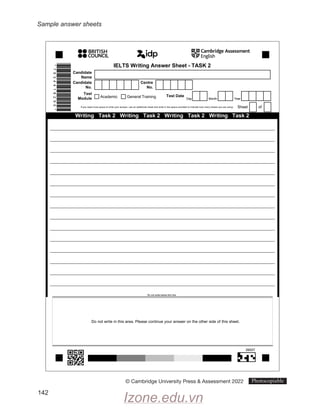Here are the answers to questions 21-26 from Part 3 of the Listening test:
21. A
22. B
23. B
24. C
25. A
26. B
Listening test audio
14
p. 119 p. 98
Izone.edu.vn
�Test 1
Questions 24–26
Choose the correct letter, A, B or C.
24 What did Diana find most interesting about her work experience?
A Observing lambing
B Helping with vaccinations
C Assisting with shearing
25 What advice does Tim give to future work experience students?
A Make sure you wear suitable clothing and footwear
B Don't
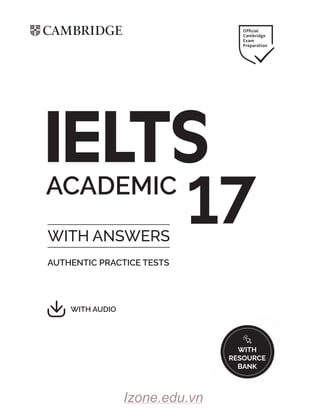
![Cambridge University Press & Assessment
www.cambridge.org/elt
www.cambridgeenglish.org
Information on this title: www.cambridge.org/9781108933810
© Cambridge University Press & Assessment 2022
It is normally necessary for written permission for copying to be obtained in advance from a publisher.
The sample answer sheets at the back of this book are designed to be copied and distributed in class.
The normal requirements are waived here and it is not necessary to write to Cambridge University Press
& Assessment for permission for an individual teacher to make copies for use within their own
classroom. Only those pages that carry the wording ‘© Cambridge University Press & Assessment 2022
Photocopiable ’ may be copied.
First published 2022
21 20 19 18 17 16 15 14 13 12 11 10 9 8 7 6 5 4 3 2 1
Printed in [TBC]
A catalogue record for this publication is available from the British Library
ISBN 978-1-108-93381-0 Academic Student’s Book with Answers with Audio with Resource Bank
ISBN 978-1-108-93383-4 General Training Student’s Book with Answers with Audio with Resource Bank
The publishers have no responsibility for the persistence or accuracy of URLs for external or third-party
internet websites referred to in this publication, and do not guarantee that any content on such websites
is, or will remain, accurate or appropriate. Information regarding prices, travel timetables, and other
factual information given in this work is correct at the time of first printing but the publishers do not
guarantee the accuracy of such information thereafter.
Izone.edu.vn](https://image.slidesharecdn.com/cambridge17test-221113122515-37a0b34a/85/CAMBRIDGE-17-TEST-pdf-2-320.jpg)


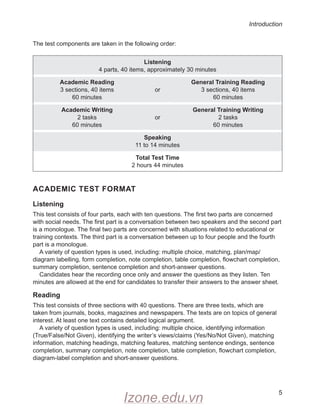





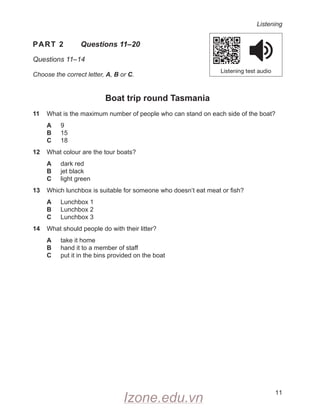
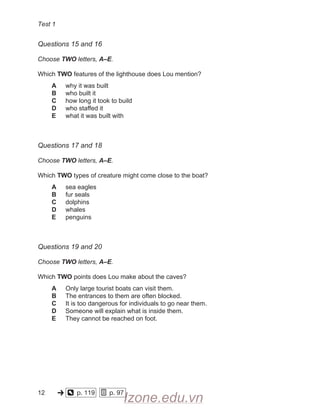














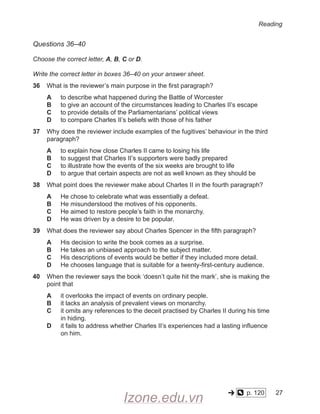
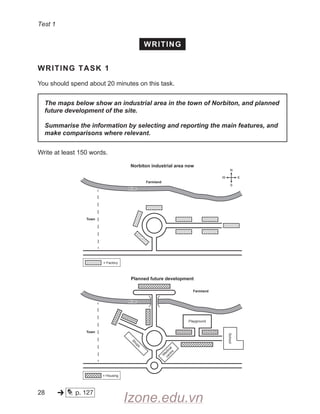

![Test 1
30
SPEAKING
PART 1
The examiner asks you about yourself, your home,
work or studies and other familiar topics.
EXAMPLE
History
• What did you study in history lessons when you were at school?
• Did you enjoy studying history at school? [Why/Why not?]
• How often do you watch TV programmes about history now? [Why/Why not?]
• What period in history would you like to learn more about? [Why?]
PART 2
Describe the neighbourhood you lived in when
you were a child.
You should say:
where in your town/city the neighbourhood was
what kind of people lived there
what it was like to live in this neighbourhood
and explain whether you would like to live in this
neighbourhood in the future.
You will have to talk
about the topic for one
to two minutes. You
have one minute to
think about what you
are going to say. You
can make some notes
to help you if you wish.
PART 3
Discussion topics:
Neighbours
Example questions:
What sort of things can neighbours do to help each other?
How well do people generally know their neighbours in your country?
How important do you think it is to have good neighbours?
Facilities in cities
Example questions:
Which facilities are most important to people living in cities?
How does shopping in small local shops differ from shopping in large city centre shops?
Do you think that children should always go to the school nearest to where they live?
Example Speaking test video
Izone.edu.vn](https://image.slidesharecdn.com/cambridge17test-221113122515-37a0b34a/85/CAMBRIDGE-17-TEST-pdf-30-320.jpg)




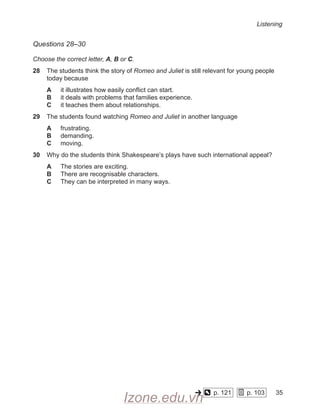
















![52
SPEAKING
PART 1
The examiner asks you about yourself, your home, work or studies and other familiar
topics.
EXAMPLE
Reading
• Did you have a favourite book when you were a child? [Why/Why not?]
• How much reading do you do for your work/studies? [Why/Why not?]
• What kinds of books do you read for pleasure? [Why/Why not?]
• Do you prefer to read a newspaper or a magazine online, or to buy a copy? [Why?]
PART 2
Describe a big city you would like to visit.
You should say:
which big city you would like to visit
how you would travel there
what you would do there
and explain why you would like to visit this big city.
You will have to talk
about the topic for one
to two minutes. You
have one minute to
think about what you
are going to say. You
can make some notes
to help you if you wish.
PART 3
Discussion topics:
Visiting cities on holiday
Example questions:
What are the most interesting things to do while visiting cities on holiday?
Why can it be expensive to visit cities on holiday?
Do you think it is better to visit cities alone or in a group with friends?
The growth of cities
Example questions:
Why have cities increased in size in recent years?
What are the challenges created by ever-growing cities?
In what ways do you think cities of the future will be different to cities today?
Test 2
Izone.edu.vn](https://image.slidesharecdn.com/cambridge17test-221113122515-37a0b34a/85/CAMBRIDGE-17-TEST-pdf-52-320.jpg)
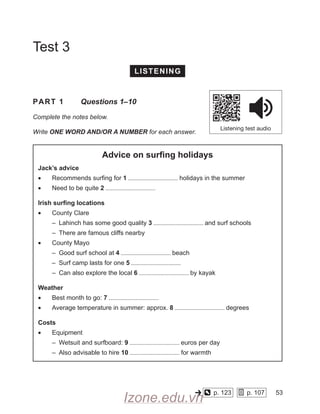






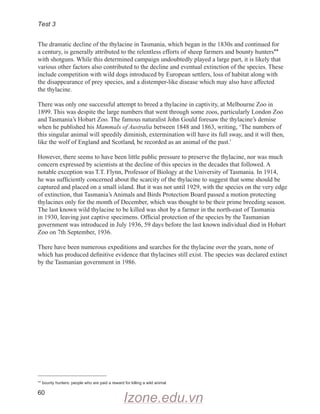
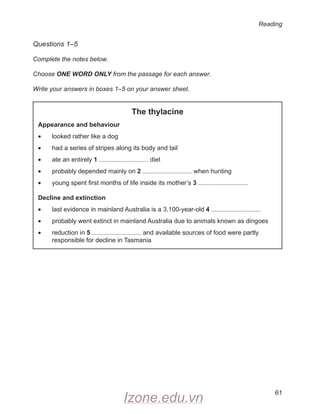


![Test 3
64
E One response to the boycott movement has been the argument for the vital role palm
oil plays in lifting many millions of people in the developing world out of poverty. Is it
desirable to have palm oil boycotted, replaced, eliminated from the global supply chain,
given how many low-income people in developing countries depend on it for their
livelihoods? How best to strike a utilitarian balance between these competing factors has
become a serious bone of contention.
F Even the deforestation argument isn’t as straightforward as it seems. Oil palm plantations
produce at least four and potentially up to ten times more oil per hectare than soybean,
rapeseed, sunflower or other competing oils. That immensely high yield – which is
predominantly what makes it so profitable – is potentially also an ecological benefit. If ten
times more palm oil can be produced from a patch of land than any competing oil, then ten
times more land would need to be cleared in order to produce the same volume of oil from
that competitor.
As for the question of carbon emissions, the issue really depends on what oil palm trees are
replacing. Crops vary in the degree to which they sequester carbon – in other words, the
amount of carbon they capture from the atmosphere and store within the plant. The more
carbon a plant sequesters, the more it reduces the effect of climate change. As Shankar
explains: ‘[Palm oil production] actually sequesters more carbon in some ways than other
alternatives. […] Of course, if you’re cutting down virgin forest it’s terrible – that’s what’s
happening in Indonesia and Malaysia, it’s been allowed to get out of hand. But if it’s
replacing rice, for example, it might actually sequester more carbon.’
G The industry is now regulated by a group called the Roundtable on Sustainable Palm Oil
(RSPO), consisting of palm growers, retailers, product manufacturers, and other interested
parties. Over the past decade or so, an agreement has gradually been reached regarding
standards that producers of palm oil have to meet in order for their product to be regarded
as officially ‘sustainable’. The RSPO insists upon no virgin forest clearing, transparency and
regular assessment of carbon stocks, among other criteria. Only once these requirements are
fully satisfied is the oil allowed to be sold as certified sustainable palm oil (CSPO). Recent
figures show that the RSPO now certifies around 12 million tonnes of palm oil annually,
equivalent to roughly 21 percent of the world’s total palm oil production.
H There is even hope that oil palm plantations might not need to be such sterile monocultures,
or ‘green deserts’, as Ellwood describes them. New research at Ellwood’s lab hints at one
plant which might make all the difference. The bird’s nest fern (Asplenium nidus) grows on
trees in an epiphytic fashion (meaning it’s dependent on the tree only for support, not for
nutrients), and is native to many tropical regions, where as a keystone species it performs a
vital ecological role. Ellwood believes that reintroducing the bird’s nest fern into oil palm
plantations could potentially allow these areas to recover their biodiversity, providing a
home for all manner of species, from fungi and bacteria, to invertebrates such as insects,
amphibians, reptiles and even mammals.
Izone.edu.vn](https://image.slidesharecdn.com/cambridge17test-221113122515-37a0b34a/85/CAMBRIDGE-17-TEST-pdf-64-320.jpg)









![74
SPEAKING
PART 1
The examiner asks you about yourself, your home, work or studies and other familiar
topics.
EXAMPLE
Drinks
• What do you like to drink with your dinner? [Why?]
• Do you drink a lot of water every day? [Why/Why not?]
• Do you prefer drinking tea or coffee? [Why?]
•
If people visit you in your home, what do you usually offer them to drink?
[Why/Why not?]
PART 2
Describe a monument (e.g., a statue or sculpture)
that you like.
You should say:
what this monument is
where this monument is
what it looks like
and explain why you like this monument.
You will have to talk
about the topic for one
to two minutes. You
have one minute to
think about what you
are going to say. You
can make some notes
to help you if you wish.
PART 3
Discussion topics:
Public monuments
Example questions:
What kinds of monuments do tourists in your country enjoy visiting?
Why do you think there are often statues of famous people in public places?
Do you agree that old monuments and buildings should always be preserved?
Architecture
Example questions:
Why is architecture such a popular university subject?
In what ways has the design of homes changed in recent years?
To what extent does the design of buildings affect people’s moods?
Test 3
Izone.edu.vn](https://image.slidesharecdn.com/cambridge17test-221113122515-37a0b34a/85/CAMBRIDGE-17-TEST-pdf-74-320.jpg)




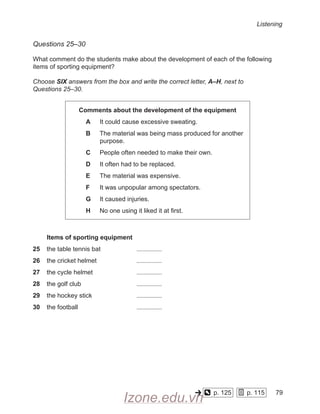



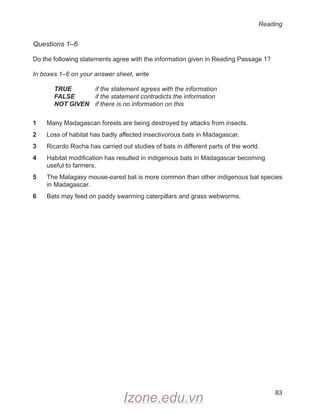











![95
SPEAKING
PART 1
The examiner asks you about yourself, your home, work or studies and other
familiar topics.
EXAMPLE
Maps
• Do you think it’s better to use a paper map or a map on your phone? [Why?]
• When was the last time you needed to use a map? [Why/Why not?]
•
If you visit a new city, do you always use a map to find your way around?
[Why/Why not?]
• In general, do you find it easy to read maps? [Why/Why not?]
PART 2
Describe an occasion when you had to do
something in a hurry.
You should say:
what you had to do
why you had to do this in a hurry
how well you did this
and explain how you felt about having to do this in
a hurry.
You will have to talk
about the topic for one
to two minutes. You
have one minute to
think about what you
are going to say. You
can make some notes
to help you if you wish.
PART 3
Discussion topics:
Arriving late
Example questions:
Do you think it’s OK to arrive late when meeting a friend?
What should happen to people who arrive late for work?
Can you suggest how people can make sure they don’t arrive late?
Managing study time
Example questions:
Is it better to study for long periods or in shorter blocks of time?
What are the likely effects of students not managing their study time well?
How important is it for students to have enough leisure time?
Izone.edu.vn](https://image.slidesharecdn.com/cambridge17test-221113122515-37a0b34a/85/CAMBRIDGE-17-TEST-pdf-95-320.jpg)


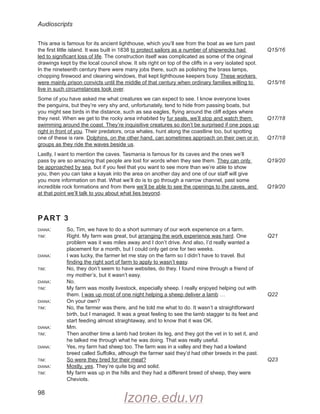


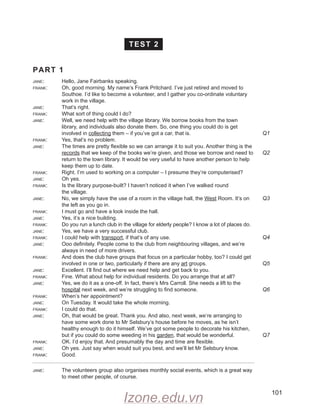
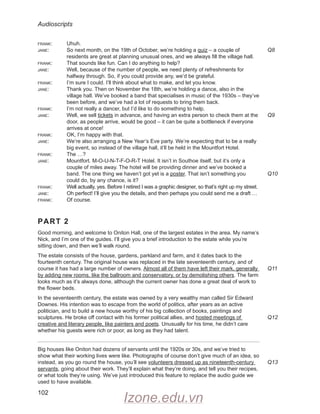




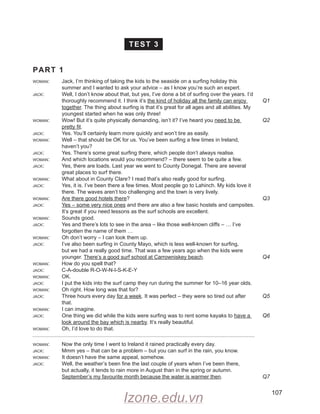


















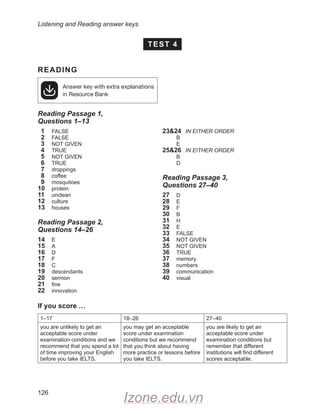
![127
Sample Writing answers
TEST 1, WRITING TASK 1
This is an answer written by a candidate who achieved a Band 6.0 score.
The two maps illustrates the norbiton area in the present days, as well as, the planned development.
Overall, the norbiton industrial area is located at the east side of the town, with a river on the
north, separating the farmland from the industrial area, which is located in the center of the map,
represented by a few factory biuldings and roads, followed by the main road at the extreme south
of the map.
the planned development shows a substantially growth and modifications of the overall
infrastructure of the area between the farmland and the main road.
Firstly, the planned development of the norbiton area replaces what once were factories
for housings.
Moreover, the roads have been developed to acomodate all the new biuldings that have been
planned for the area, which are, a school and a playground to the east side of the roundabout
located in the center of the map, as well as shops and a medical center around the round about.
Secondly, a bridge is planned for the north of the map to cross the river and provide acess to the
housing that will be located in farmland.
Here is the examiner’s comment:
This response covers the key changes to be made to the industrial area, although
more detail could be provided, for example, housing to the west of the roundabout.
There is an overview in the second paragraph and the response could be improved
by adding a summary of the main changes.
Ideas are arranged coherently, with some effective use of cohesive devices [what
once were], sequencing adverbs [Firstly | Secondly] and referencing [which | that].
There is some less common vocabulary but spelling is often inaccurate [acomodate
/ accommodate | biuldings / buildings] and word formation is incorrect [substantially
growth / substantial growth].
To achieve a higher score, the candidate would need to reduce the number of
errors in vocabulary and sentence structure.
Additional sample Writing answers
in Resource Bank
Izone.edu.vn](https://image.slidesharecdn.com/cambridge17test-221113122515-37a0b34a/85/CAMBRIDGE-17-TEST-pdf-127-320.jpg)

![129
Here is the examiner’s comment:
This response discusses the advantages and the disadvantages of taking risks.
It puts much greater emphasis on risks in ‘professional life’. As this response is
below 250 words (it is only 242), more could be added to include risks in ‘personal
life’ along with some specific examples of risks that people commonly take. There
is a clear progression through the response and ideas are logically organised;
disadvantages are presented first and advantages second. Cohesive devices can
be quite mechanical with examples at the start of most sentences [First of all |
However | On the other hand | Firstly] but referencing is generally appropriate [it |
this loss | They | The failure]. The first paragraph is very short and paragraphing is
not entirely logical.
Vocabulary is effective with some less common items [damage the society | receive
huge benefits | enable | obtain advantages … from the process]. Occasional errors
remain [object / objective | point / perspective]. Sentence structure is good, with
frequent error-free sentences. There is a variety of complex structures, including
conditionals [if], but a few errors remain.
To improve this response, the word count of 250 should be reached and concrete
example(s) of risk could be provided.
Sample Writing answers
Izone.edu.vn](https://image.slidesharecdn.com/cambridge17test-221113122515-37a0b34a/85/CAMBRIDGE-17-TEST-pdf-129-320.jpg)
![130
Sample Writing answers
TEST 2, WRITING TASK 1
This is an answer written by a candidate who achieved a Band 7.5 score.
The table illustrates the data on the police budget in which the money came from and the two pie
charts describe the distribution of the amount of money in the two of year 2017 and 2018 in an
area of Britain. Overall, there was an upward trend in all three different sources while the money
spent on salaries was always the majority of contribution.
Looking into more details, the highest amount of money on the police budget belonged to ‘National
Government’, 175.5 million pounds in 2017 and it kept rising to 177.8 million pounds. Thus was
followed by ‘Local Taxes’, at 91.2 million pounds in 2017, after one year, it increase significantly to
102.3 million pounds.
In term of the how the money was spent, the majority of police budget goes to salaries which was
for officers and staff, dropping slightly from 75% in 2017 to 69% in 2018. Meanwhile, the proportion
of ‘Buildings and transport’ remained constantly, at 17% each year. An opposite pattern can be seen
in the category of technology, its figure rose sharply from 8% in 2017 to 14% in 2018, which was
always the lowest rate during the given period.
Here is the examiner’s comment:
This is a strong response. The candidate provides a clear overview at the end of
the first paragraph which highlights the consistently increasing trend from the table
and identifies the largest category from the pie charts. Full details are given for the
first two sources of the budget but, to achieve a higher rating, key features in the
table could be more fully extended.
Information is presented in the order of the table first and then the charts, in a
logical manner. The test taker demonstrates a good range of cohesive devices
[while | which was] and uses three paragraphs appropriately to organise and
sequence the required data.
There is a wide range of vocabulary [figure rose sharply | during the given period]
with accurate spelling, although there are occasional errors in word choice. The
range of grammatical structures is wide, including modal [can] and continuous
forms [kept rising] – although there are occasional errors e.g. using present tenses
[goes on] to describe data from 2017 and 2018.
To improve this response, the key features presented from the table could be
more fully extended. The candidate could also reduce the few errors in sentence
structure.
Izone.edu.vn](https://image.slidesharecdn.com/cambridge17test-221113122515-37a0b34a/85/CAMBRIDGE-17-TEST-pdf-130-320.jpg)

![132
Here is the examiner’s comment:
This response addresses both parts of the question. A range of ideas is expressed
and the candidate gives their position in the opening paragraph and then provides
evidence and relevant examples.
Ideas are logically organised and there is clear progression throughout the four
paragraphs. A range of cohesive devices are used [The first reason | For instance |
Moreover] with referencing used appropriately [they | themselves | their studies | it].
The range of vocabulary is good with examples of higher-level items [social skills |
restriction of distance | ultimately] and there are few errors [overusage / overuse |
niece … he / niece … she | watchin / watching | require to know / needs to know].
Similarly, the range of grammatical structures is reasonable, but the level of error
means the Band Score cannot be higher than 6.5.
Sample Writing answers
Izone.edu.vn](https://image.slidesharecdn.com/cambridge17test-221113122515-37a0b34a/85/CAMBRIDGE-17-TEST-pdf-132-320.jpg)
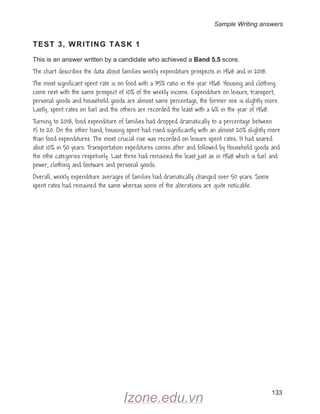
![134
Here is the examiner’s comment:
This response clearly presents the data from the bar graph. The candidate presents
all the data for 1968 first and then the data for 2018. There is an overview in the
final sentence, but it should summarise the main changes from the bar chart
rather than just saying that expenditure ‘had … changed’. Information is arranged
coherently into four paragraphs, and there is clear overall progression. A range
of cohesive devices is used [Turning to 2018 | followed by | whereas] with an
awareness of referencing [former one | the othe categories | Last three].
There are some less common examples of vocabulary [dropped dramatically to |
rised significantly | soared]. Errors remain [spent rates / expenditure | housing
spent / housing costs] but do not impede communication. Similarly, grammatical
structures include some complex forms [had dropped … to] and sentences with
multiple clauses; however, there are errors, including inconsistent use of articles
and with past tenses.
To improve the response, a summary of the main trends from the bar chart is
needed in the overview; for example, the candidate could say that there has been
a significant decrease in spending on food over the 50-year period, but the cost of
leisure, housing and transport has significantly increased.
Sample Writing answers
Izone.edu.vn](https://image.slidesharecdn.com/cambridge17test-221113122515-37a0b34a/85/CAMBRIDGE-17-TEST-pdf-134-320.jpg)

![136
Here is the examiner’s comment:
This response addresses both parts of the question. Both views are considered
and an opinion is given. For a higher rating, fuller coverage on the first point, the
requirement to ‘work in the country where they did their training’ could be included.
Organisation is logical and there is clear progression thorough the four paragraphs.
The range of vocabulary is good with examples of higher-level items [hands-on
experience | compensate | better opportunities overseas], but there are a number
of errors [theat / that | believes / beliefs | lease / leaves | miving / moving]. Similarly,
the range of grammatical structures is reasonable, but the level of error means the
Band Score cannot be higher than 6.5.
Sample Writing answers
Izone.edu.vn](https://image.slidesharecdn.com/cambridge17test-221113122515-37a0b34a/85/CAMBRIDGE-17-TEST-pdf-136-320.jpg)
![137
TEST 4, WRITING TASK 1
This is an answer written by a candidate who achieved a Band 7.5 score.
The line graph shows trends in shop closures and openings of new shops in a particular country
between the years 2011 and 2018.
In 2011 approximately 6,400 shops closed. The number of closures fluctuated over the next four
years until 2015, when there was a dramatic fall in closures to roughly 700 shops. The following year
the number of shops closing their doors rose sharply, reaching over 5,000. The figures remained
steady for the next two years, with just over 5,000 closures in 2018.
The number of new shops opening decreased dramatically between 2011 (approximately 8,500) and
2012 ( just under 4,000) but rebounded by roughly 50% by 2014. In 2015, the number of openings
then fell to the 2012 level, but remained stable for the next two years. The last recorded year, 2018,
saw a further fall to 3,000 new openings, the lowest point in this seven year period.
Overall, the number of shop closures has remained within the 5,000 to 7,000 range (with the
exception of 2015). In contrast, new shop openings have shown a wider range of figures, but
generally indicate a downward trend over the same period.
Here is the examiner’s comment:
This is a strong response which provides a clear overview in the final paragraph.
Data is presented and key features are highlighted appropriately. Closures are
dealt with first, and the details are clearly presented, including the [dramatic fall]
key feature. Shop openings are dealt with separately, in similar detail. Key peaks
and low points are appropriately flagged.
For the highest task score, there could be more detail provided during the periods
of [fluctuation] between 2011 to 2014 and 2016 to 2018.
Ideas are logically organised, taking each line on the graph in turn, and
paragraphing is used appropriately, apart from the single sentence first paragraph.
Cohesion is well managed.
The range of vocabulary is wide, with some skilful use [rebounded by roughly |
further fall | exception of]. The grammar includes a variety of complex structures,
with numerous long sentences containing a number of clauses. This is a good
example of a higher-level response to this Task 1 question.
Sample Writing answers
Izone.edu.vn](https://image.slidesharecdn.com/cambridge17test-221113122515-37a0b34a/85/CAMBRIDGE-17-TEST-pdf-137-320.jpg)
![138
TEST 4, WRITING TASK 2
This is an answer written by a candidate who achieved a Band 6.0 score.
Since ancient times people tried to treat themselves by herbals and another natural products. In
these days this type of treatment is named as alternative medicine. Nowadays, more and more
people with some diseases decide to use alternative medicines instead of classic medicine. In this
essay I will try to discuss pros and cons.
In my opinion, the disadvantages outweigh the advantages of using traditional medicine. The first
reason is that nobody knows how this treatment will affect to a person’s health. There are a lot of
cases when using different herbals caused allergic reaction and some people dead. The next reason
is that people who do not have any medical education try alternative medicines. They do not know
what the result will be and hope that it will be positive but not always is like that.
Although there are a lot of disadvantages, advantages might make people not go to usual doctor.
The first and the main pro is that using herbals does not cause environmental problems such as air
pollution or gas waste. Many pharmaceutical plants use chemicals which have harmful affect on the
environment. The other reason is that alternative medicines are usually much cheaper than usual
treatment as you do not have to go to pharmacy and buy expensive drugs.
To sum it up, the alternative treatment will be forever because it has some advantages which many
people think that they can outweigh the disadvantages but I do not think so. The conventional
medicine which develops rocketly will drive out other types of treatment in the future.
Here is the examiner’s comment:
The response addresses both sides of the question and the candidate states
their position in the second paragraph. The disadvantages presented include not
knowing if the treatments will work, possible allergic reactions and the dangers
of untrained practitioners. The advantages include remedies being kinder to the
environment and usually cheaper.
Ideas are arranged coherently with a range of cohesive devices, although
organisation is sometimes mechanical due to the high number of linking devices.
There is evidence of referencing [chemicals which | it] with some error [that they
can outweigh / outweigh].
Vocabulary is used adequately and there are some good examples used [allergic
reaction | pharmaceutical plants | conventional medicine]; however, some errors
remain [dead / die | rocketly / very quickly]. Grammatical structures include some
sentences with multiple clauses [which have | as you]. However, there are errors
[not always is like that / it is not always] and most sentences are short and simple.
Sample Writing answers
Izone.edu.vn](https://image.slidesharecdn.com/cambridge17test-221113122515-37a0b34a/85/CAMBRIDGE-17-TEST-pdf-138-320.jpg)



